
About UsThe Numismatic Bibliomania Society is a non-profit organization promoting numismatic literature. For more information please see our web site at coinbooks.org SubscriptionsThose wishing to become new E-Sylum subscribers (or wishing to Unsubscribe) can go to the following web page link MembershipThere is a membership application available on the web site Membership Application To join, print the application and return it with your check to the address printed on the application. Membership is only $15 to addresses in the U.S., $20 for First Class mail, and $25 elsewhere. For those without web access, write to: David M. Sundman, Secretary/TreasurerNumismatic Bibliomania
Society AsylumFor Asylum mailing address changes and other membership questions, contact David at this email address: dsundman@LittletonCoin.com SubmissionsTo submit items for publication in The E-Sylum, just Reply to this message, or write to the Editor at this address: whomren@coinlibrary.com
BUY THE BOOK BEFORE THE COINYou won't regret it! |
- WAYNE'S WORDS: THE E-SYLUM MARCH 29, 2009
- NEW BOOK: HEY! MISTER HORN BLOWER BY GENE HESSLER
- MORE ON LINCOLN: THE IMAGE OF HIS GREATNESS BY FRED REED
- MORE ON ROGER DEWARDT LANE'S MODERN DIME SIZE SILVER COINS BOOK
- GLEANINGS FROM RECENT NUMISMATIC PERIODICALS
- LONG-LOST FABERGE CONTRAPTION DISCOVERED
- MORE ON WILLEM'S UNITED STATES TRADE DOLLAR BOOK
- ANA LIBRARY HAS A NEW ONLINE LOOK
- QUERY: ARLIE SLABAUGH'S COMMEMORATIVE COINAGE RESEARCH NOTES SOUGHT
- QUERY: AUSTRIAN NOTGELD REFERENCE SOUGHT
- QUERY: CORPUS OF THE COINS OF THE JEWISH WAR
- MORE ON NUMISMATIC MOTTO TRANSLATIONS
- NEW COIN LAYING RECORD: 65 MILES!
- QUIZ ANSWER: HENRY BEMIS, LAST BIBLIOPHILE ON EARTH
- NUMISMATIC PUBLICATIONS: ELECTRONIC VERSIONS EDGING OUT PRINT?
- 1931 BAYONNE BRIDGE DEDICATION MEDAL
- MORE ON BROCKAGES
- BRITAIN'S LARGEST COUNTERFEITING RING ABOUT TO BE SENTENCED
- BANK OF ENGLAND EXHIBIT: THE TENNER
- COIN CARVER ALLAN FEINBERG
- WOMAN CASHES IN DOUBLE EAGLE GOLD COINS AT FACE VALUE FOR GROCERY MONEY
- FEATURED WEB SITE: LUDWIG GIES: CAST ART MEDALS FROM THE GREAT WAR
WAYNE'S WORDS: THE E-SYLUM MARCH 29, 2009
 We now have 1,225 subscribers. This week we open with information on Gene Hessler's new autobiography, more commentary on Fred Reed's Lincoln book, an update from Roger Lane on his Dime Size Silver Coins book, and a look at several articles from recent numismatic periodicals.
We now have 1,225 subscribers. This week we open with information on Gene Hessler's new autobiography, more commentary on Fred Reed's Lincoln book, an update from Roger Lane on his Dime Size Silver Coins book, and a look at several articles from recent numismatic periodicals.Queries this week include Arlie Slabaugh’s research notes and Austrian Notgeld. To learn how NOT to pay for your groceries at Wal-Mart , read on. Have a great week, everyone!
Wayne Homren
Numismatic Bibliomania Society
NEW BOOK: HEY! MISTER HORN BLOWER BY GENE HESSLER
 Hey! Mister Horn Blower is the life story of native Cincinnatian Gene Hessler—musician and numismatist. Gene returned to his native Cincinnati 40 years after attending the Cincinnati Conservatory of Music and U.C., where he received his degree in 1955. (He graduated from Assumption School in 1942 and Mt. Healthy High School in 1946.)
Hey! Mister Horn Blower is the life story of native Cincinnatian Gene Hessler—musician and numismatist. Gene returned to his native Cincinnati 40 years after attending the Cincinnati Conservatory of Music and U.C., where he received his degree in 1955. (He graduated from Assumption School in 1942 and Mt. Healthy High School in 1946.) Prior to leaving Cincinnati Gene fronted his own dance band that played numerous college dates in OH, IN, KY and WVA and Cincinnati ballrooms: Moonlight Gardens, Castle Farm, and the Topper Club. While in the army he performed with Cannonball and Nat Adderley.
After traveling with a few name bands including Woody Herman, Billy May and Elliot Lawrence, Gene moved to New York City. Gene received his Master’s degree from the Manhattan School of Music and remained in New York City to work as a free-lance and recording musician. He was a member of the orchestras for Broadway shows including the Music Man, Camelot, Annie and a dozen others. He also was a member of the Radio City Music Hall orchestra.
Gene performed with Doc Severinsen, Nina Simone, Sammy Davis, Jr., Diana Ross and many others. A few of the people he performed with on Broadway include Julie Andrews, Richard Burton, Barbra Streisand, Robert Preston and Carol Burnett; and in the classical field, Joan Sutherland, Rïse Stevens and Eileen Farrell. He also performed at Lincoln Center, Carnegie Hall and the Metropolitan Opera under the batons of Leonard Bernstein, Leopold Stokowski and other world-famous conductors. In addition Gene performed with the Bolshoi Ballet Orchestra and the Leningrad Philharmonic when they were in NYC.
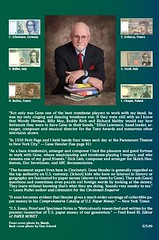 Along the way Gene became interested in the history of money: coins at first then he discovered the beauty of paper money. Lester Merkin and Dr. Glenn E. Jackson were his mentors. Though he never left music, Gene was the curator of The Chase Manhattan Bank Money Museum from 1967-1977, and the Mercantile Bank Money Museum in St. Louis in the mid-1980s.
Along the way Gene became interested in the history of money: coins at first then he discovered the beauty of paper money. Lester Merkin and Dr. Glenn E. Jackson were his mentors. Though he never left music, Gene was the curator of The Chase Manhattan Bank Money Museum from 1967-1977, and the Mercantile Bank Money Museum in St. Louis in the mid-1980s.Hessler has authored five award-winning books. His first was the Comprehensive Catalog of U.S. Paper Money, now in its 7th edition. “I was pleased and excited” Hessler said, “when I uncovered U.S. essays, unissued bank notes at the U.S. Bureau of Engraving and Printing.” These were documented and illustrated in U.S. Essay, Proof and Specimen Notes, now in its 2nd edition. His third book was An Illustrated History of U.S. Loans, 1775-1898, which included many illustrations not seen since the notes circulated in the mid-19th century.
Hessler’s research of engravers and designers who worked in the U.S. was published in The Engraver’s Line. This motivated him to compile similar data for engravers and designers from other countries; the result was The International Engraver’s Line. In addition Gene was editor for PAPER MONEY, the journal of the Society of Paper Money Collectors for 14 years and has written over 350 magazine and journal articles.
Gene Hessler has appeared on the NBC Today Show twice, What’s My Line and Wonderama, all in the 1970s. In addition to these national television appearances he recorded a series of historical and human interest stories about coins and paper money entitled “Did You Know…” for The Chase Manhattan Bank. These were broadcast in markets where Chase Banks operated. Gene also wrote over 30 scripts for the American Numismatic Association’s Money Talks, broadcast on National Public Radio. One of his scripts was selected to represent the series when it was nominated for a Peabody Broadcasting Award in 1993.
With this eclectic background that included U.S. State Department tours through Africa (1964) and a trip around the world with the Cincinnati Symphony Orchestra (1966), friends and relatives convinced Mr. Hessler to write and publish his memoirs originally intended only for family and friends.
By the time Gene returned to Cincinnati in 1996 he had put away his trombone. He continues to research the history of paper money and those artists and engravers who helped to create so many foreign bank notes that are so beautiful and collectible.
In August of 2008 Gene Hessler received the American Numismatic Association’s (ANA) highest award, the Farran Zerbe Award. The Numismatist, the ANA journal carried a story by Fred Schwan in which he concluded: “It seems to me the Cincinnati Music Center half dollar, released by the U.S. Mint in 1936, actually proclaims Gene’s achievements in music and the hobby. Among other things, it was issued at about the time Gene discovered numismatics with a Buffalo nickel. The commemorative’s reverse legend reads CINCINNATI – A MUSIC CENTER OF AMERICA. In his way, Gene Hessler is proof of that. (For an image of the half dollar on the Internet Google “Constance Ortmayer” (the designer) then click on image.
In the foreword of the book Zane L. Miller, Charles Phelps Taft Professor of History Emeritus, University of Cincinnati says “Gene is a smart and multi-talented German American who grew up in a mostly German American working class suburb of Cincinnati during the Great Depression and World War II. But in the l940s he started on the construction of two fabulous careers, one as an accomplished musician—jazz, popular, and classical—(a rare combination of genres in the mid-20th century), and later as a world class expert on the history, design and engraving of paper money issued by governments, all over the globe.”
Direct all inquiries to the author at PO Box 31144, Cincinnati, OH 45231 or engraversline@aol.com. The price of the soft cover book is $25, and for one of the 100 hard cover copies, $35. For a limited time there will be no charge for mailing either book in the U.S. Please be prepared to accept the soft cover version if the hard cover version is sold out. (The price difference be will be refunded.) Please mention if you want the book signed with a simple signature, a personalized inscription, or neither.
MORE ON LINCOLN: THE IMAGE OF HIS GREATNESS BY FRED REED
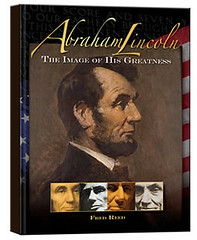 With a second week of reading Fred Reed's new book, Abraham Lincoln: The Image of His Greatness I am even more impressed with this work. If ever there was one book to establish an author's star position in the numismatic firmament, this is it. Reed's reputation will be forever assured as a numismatic authority with this one publication.
With a second week of reading Fred Reed's new book, Abraham Lincoln: The Image of His Greatness I am even more impressed with this work. If ever there was one book to establish an author's star position in the numismatic firmament, this is it. Reed's reputation will be forever assured as a numismatic authority with this one publication. In last week's E-Sylum I stated I could not find even one error. It took me a week to do just that. I found one sort-of error and three typos. On page 110 the author attributes a Lincoln medal (King 284) to "Miller New York." This piece was engraved by M. Henry Miller of Louisville, Kentucky. Not that serious. The other minor typos were name spellings: Millet (page 170) and Picket (page 144) both have one "T" at the end; and John Mowbry Clark (page 189) was missing the "W."
One design criticism: the call-out keys identifying an illustration to its caption were tiny letters in tiny diamonds with shaded backgrounds. These were impossible to see with these old eyes; it required me to use a magnifying glass. Had Whitman left the diamonds open without the shading it would have improved readability.
Now I have to admit my own error. In last week's review I stated there were 926 illustrations. Atrocious arithmetic - the actual count was 967, far closer to the statement in the book of "nearly 1,000 illustrations." It could be even more than 967 counting the cover photos.
Also Whitman Publishing is to be commended for publishing this book in addition to kudos for the author. I am certain the prepublication costs were higher than most numismatic books. I cannot imagine the graphic art costs for laying out every page differently and handling that many illustrations, mostly in color. Lots of praise due there!
I anticipate more and more numismatic authors are now going to offer their manuscripts to Whitman because of the success of this book. But analyze your own work, authors. Is it a "blockbuster" like this book? Can it be sold to a wide spectrum of buyers? Too many of us are concerned with our own little collecting specialty and that is what we write about. For years I wondered how many readers wanted to buy The Coins of the Umayyads of Spain (copublished by ANS). Whitman could never publish that. (Thankfully nonprofit institutions can).
Jeff Reichenberger adds:
The never-ending images are captivating, as is the chronological history that flows throughout. A wonderful addition to any numismatic library, and further, anyone interested in Lincoln history. My copy will jump back and forth from my Lincoln history shelf to my miscellaneous numismatic interests shelf.
Bob had been working on the project for some time, and he learned that Fred Reed had also been working on encased postage research. He and I joined forces with Fred, who would pull all of our research together and write the final book.
I was just a young pup in numismatic research, and gladly followed up on Fred's leads, once traveling to Princeton University to find a letter from Gault to President Lincoln. I learned that Fred was extremely thorough in searching out the facts. He would compile information from multiple sources, cross-check, and only write what he felt was justified by the information at hand. It was a very long process. Bob grew impatient, but I maintained faith, although I too, at times wondered whether the tightly-guarded manuscript would ultimately be published.
But Fred came through despite a number of obstacles and distractions that would have discouraged many a potential author. Fred was exactly the right person to lead the effort and write the book. Bob, while an enthusiastic researcher, was not the most organized, and certainly not a writer. I was a pretty good writer, but at that age not nearly as good or as organized as required for such a project. Fred pulled together a book that far eclipsed anything written on the subject before or since. I'm proud to have been a contributor, but Fred rightly deserves the credit.
Encased Postage Stamps are a topic just as narrow as the coins of the Umayyads of Spain. It wasn't easy or cheap to get the book published then, and it wouldn't be today. Fred's tireless efforts on all of his publications, from the Encased Postage, Show Me the Money and Lincoln books, plus his editing of Paper Money and writing in Bank Note Reporter all deserve the highest recognition of our hobby. -Editor
MORE ON ROGER DEWARDT LANE'S MODERN DIME SIZE SILVER COINS BOOK
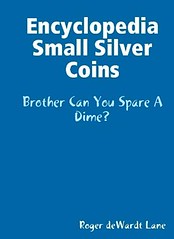 I seem to make major changes about the time of my birthday each year. Well, today was my 82nd Birthday.
I seem to make major changes about the time of my birthday each year. Well, today was my 82nd Birthday.Two days ago I took down almost all the links to the pages of my 'Free' E-book on my website. The home page was updated to show how anyone can buy the book in both softcover or hardcover. I just found that Google Books had the book listed tonight. What a Birthday present!
Google Books put up the whole 600 pages, indexed for search, so anyone can enter any keyword and see the pages, one at a time. I had signed up for this arrangement last year, but a little red tape (permissions) delayed the process, until I contacted them again this week.
I'm watching the activity as since I first put it up (October 2007) there have been over 30,000 page hits per year. I expect it to slow down now, however I might sell a few more copies of the softcover. Amazon and Barnes & Noble sell it for about $45.00 with free shipping. And 12,500 book sellers around the world will order it for their countrymen at about the equivalent of $50. plus some shipping.
For more information on Roger's book, see Encyclopedia of Small Silver Coins (http://dewardt.net)
THE BOOK BAZARRE
GLEANINGS FROM RECENT NUMISMATIC PERIODICALS
 The cover article in the latest Brasher Bulletin, the newsletter of the Society of Private and Pioneer Numisamtics (SPPN), is a piece by David McCarthy unveiling new information about the most famous of all U.S. private gold coins. The title is Alexander Hamilton and the World's Most Desirable Coin - Recently Discovered Hamilton Letters Reveal Important Information about the Mysterious Brasher Doubloon.
The cover article in the latest Brasher Bulletin, the newsletter of the Society of Private and Pioneer Numisamtics (SPPN), is a piece by David McCarthy unveiling new information about the most famous of all U.S. private gold coins. The title is Alexander Hamilton and the World's Most Desirable Coin - Recently Discovered Hamilton Letters Reveal Important Information about the Mysterious Brasher Doubloon.The article recounts an exchange of letters between Hamilton and William Seton, the cashier of the Bank of New York.
McCarthy's Brasher research is also the cover article on the April 2009 issue of The Numismatist from the American Numismatic Association. Other great articles in the issue include Nancy Oliver & Richard Kelly's article on The Selby Refinery Works Robbery, an interesting tale of how a single man stole nearly half a ton of gold.
Also in the issue is John Kraljevich's Early American Money column, focusing this month on the "First Family of Bank Note Printing", the Green family.
Outspoken, patriotic, talented and adventurous, the men and women of the Green family left a long legacy in ink and paper to be collected by students of history today.
 I would also like to mention W. David Perkins' article in the March 2009 issue of the John Reich Journal titled A Most Interesting 1798 B-19 Dollar
I would also like to mention W. David Perkins' article in the March 2009 issue of the John Reich Journal titled A Most Interesting 1798 B-19 DollarLot 42 especially interested me, and armed the dealer as my agent to bid in on this piece. After all, the Dollars of 1798 are a specialty of mine.
Lot # 42 A Sewing Needle Cushion Wheel Constructed Using a 1798 Large Eagle Draped Bust Silver Dollar. VF. One of the most interesting items of its kind that this cataloger has ever handled, this needle cushion wheel has a blank base with a 1798 Large Eagle Dollar serving as the top.
 The coin itself grades EF Details, and several pins are still stuck into the cushion. Additionally, the handle that once attached this cushion wheel to (probably) a sewing machine stand is still present and fully functional. All metal components are originally and attractively toned in steel-gray patina, and there really are no significant problems. The amount of detail remaining to the Dollar suggests that this fascinating piece was constructed no later than the early 19th century.
The coin itself grades EF Details, and several pins are still stuck into the cushion. Additionally, the handle that once attached this cushion wheel to (probably) a sewing machine stand is still present and fully functional. All metal components are originally and attractively toned in steel-gray patina, and there really are no significant problems. The amount of detail remaining to the Dollar suggests that this fascinating piece was constructed no later than the early 19th century. 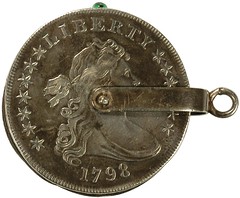
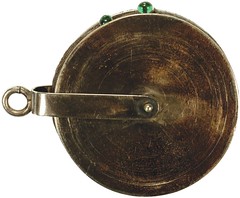
Interesting piece! Back on the numismatic research front, equally as important as the recent Brasher Doubloon findings is Bob Merchant's article in the February 2009 issue of the TAMS Journal, the official publication of the Token and Medal Society. The article, about a famous (and mysterious) counterstamp seen on U.S. coins, is titled Vote the Land free: A Recent Discovery Solves the Mystery.

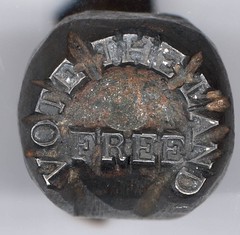
Bob located the original punch used to make the counterstamps at the Kansas Historical Society, and paid to have photos taken. Images of the punch are now on the society's web site. Above is an image of one of the coins alongside a mirror image of the punch.
To see the complete punch images at the Kansas Historical Society, see: Vote the land free (www.kansasmemory.org/item/212514)
LONG-LOST FABERGE CONTRAPTION DISCOVERED
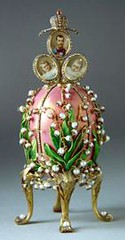 It's non-numismatic, but I know this will interest many of our readers, as it did me. Back during my stint in London I had some enjoyable dinner conversations with John P Andrew, Coin World's London correspondent. I learned that in addition to coins, he is also an expert on silver art and the works of Peter Carl Fabergé.
It's non-numismatic, but I know this will interest many of our readers, as it did me. Back during my stint in London I had some enjoyable dinner conversations with John P Andrew, Coin World's London correspondent. I learned that in addition to coins, he is also an expert on silver art and the works of Peter Carl Fabergé. Russian jeweler Fabergé (1846–1920) was best known for the famous Fabergé eggs, made in the style of genuine Easter eggs, but using precious metals and gemstones rather than more mundane materials. I thought John had had one too many drinks when he relayed the account of an unusual machine Fabergé built to speed the manufacture of his precious eggs. But the machine held a secret.
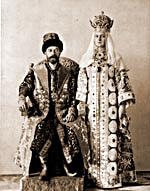 Under growing scrutiny by competitors jealous of his close ties to the Czar and his family, Fabergé decided to pull one over on them. Not wishing to divulge even the most mundane steps of his manufacturing process, he hid them within a glorious contraption he demonstrated on rare occasions to selected visitors to his store in St. Petersburg. Silver, gold, diamonds and rubies went in one end, and after over an hour of tapping, clanging and hammering, out popped a fabulous Fabergé egg from the other end.
Under growing scrutiny by competitors jealous of his close ties to the Czar and his family, Fabergé decided to pull one over on them. Not wishing to divulge even the most mundane steps of his manufacturing process, he hid them within a glorious contraption he demonstrated on rare occasions to selected visitors to his store in St. Petersburg. Silver, gold, diamonds and rubies went in one end, and after over an hour of tapping, clanging and hammering, out popped a fabulous Fabergé egg from the other end. Fabergé's contraption was secretly modeled after the famous Mechanical Turk, a machine designed by an Austrian tinkerer and scientist in the late 1700s - a time when machines that could simulate some aspect of life were apparently all the rage at Europe’s courts. On the more charming side was a boy playing the flute, whose wind-up gears actually produced a flute-like sound. On the less charming side was a replica of a duck, whose primary enchantment was that when fed, his wind-up gears took the food through the process of digestion, including the excretions at the end.
Fabergé's contraption was secretly modeled after the famous Mechanical Turk, a machine designed by an Austrian tinkerer and scientist in the late 1700s - a time when machines that could simulate some aspect of life were apparently all the rage at Europe’s courts. On the more charming side was a boy playing the flute, whose wind-up gears actually produced a flute-like sound. On the less charming side was a replica of a duck, whose primary enchantment was that when fed, his wind-up gears took the food through the process of digestion, including the excretions at the end. The mechanical Turk was far more impressive than any other machine of its day, because it seemed to be able to think. The machine was a large table, which housed the machine’s gears, and the figure of an Ottoman Turk. What the machine did was to play chess, very, very well. Onlookers were astonished, but in the end it was all a hoax - hidden inside the "machine" was a master chess player, manipulating the arms and hands of the Turk.
Inside Fabergé's machine, hidden from view, was a midget master jeweler who assembled the eggs from an array of partially completed components. Although there were many skeptics, Rasputin quelled them, implying that the work of the devil was somehow involved. Most thought it best not to question, although some wags called the contraption "Fabergé's Chicken".
 Well, to bring the story to the present, a Russian newspaper reported this week that during the demolition of Fabergé's former store building in St. Petersburg, workman found a set of crates in an attic storeroom that appear to contain the complete workings of the machine. The Hermitage Museum has hired a team of top mechanical engineers and craftsmen to reassemble it for a new exhibit on Fabergé scheduled to open in 2011.
Well, to bring the story to the present, a Russian newspaper reported this week that during the demolition of Fabergé's former store building in St. Petersburg, workman found a set of crates in an attic storeroom that appear to contain the complete workings of the machine. The Hermitage Museum has hired a team of top mechanical engineers and craftsmen to reassemble it for a new exhibit on Fabergé scheduled to open in 2011.To read the original article, see: Now We Know Which Came First: Fabergé Chicken Found in St. Petersburg Building (http://www.pseudology.org/Bank/Faberge.htm)
MORE ON WILLEM'S UNITED STATES TRADE DOLLAR BOOK
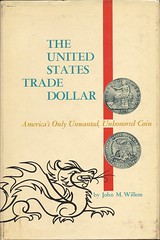
Roger Burdette writes:
Tom DeLorey also reports having a dust-jacketed copy of the 1965 Whitman edition.
Dave Lange writes:
When only one person is quoted in an article, often I'll preface their remarks in a shaded block and state their name, but don't add additional quotes since that seems redundant. In any event, sorry for the confusion. -Editor
Tom Wetter writes:
With regards to dust jackets, my copy of the first edition has an intact, seemingly very fragile, I would say 'onion skin' or tissue-paper-like dust jacket, with no type or images on it. My second edition dust jacket uses the standard pictorial as you have pictured.
Bob Van Ryzin writes:
I picked up my first edition as a withdrawn book from the Oshkosh (Wis.) Public Library for 50 cents or a $1. According to a plate inside, it was donated to the library by the author in 1961. On the page prior to the contents, it notes that: “This library edition of THE UNITED STATES TRADE DOLLAR has been printed at The Marchbanks Press in a limited edition of 1,000 copies.” I wonder if there are two versions or if all copies had this notation.
The dust jacket for my 1965 Whitman copy has long since disappeared, but the book is in decent shape.
There were indeed two versions of the first edition. George Kolbe writes:
“First of all, I wanted to write the book in my own way. This has nothing to do with conceit... I was concerned that some outside publisher might feel very strongly about putting the story together in some other way. In order to pay for the book, I literally have to charge $10 per copy... In view of the fact that the bills are paid, I am in no hurry to sell the full complement of 500 copies... Now you ask about my distribution of the 1,000 copies to public libraries and educational institution... The library copies, almost without exception, are being donated.”
Willem alludes to the existence of two editions. Both were well-printed and nicely bound in sturdy blue cloth. Privately printed at the Marchbanks Press, one was issued in a numbered edition of 500 copies, signed by the author (and sometimes inscribed by him to numismatic worthies); the other was a “library edition” limited to 1000 copies. The library copies seem to have been largely retained by their recipients and appear far less often than their numbered cousins.
Not all that many years ago, our stock included multiple brand new dust-jacketed copies of the Whitman edition, perhaps two dozen or so. They were not easy to sell and the last one probably went out the door in the late nineties. The inexpensive binding does not lend itself well to use, although the dust jacket, to its own detriment, has served its protective role, to one degree or another.
In the "what might have been" category, John M. Willem, Jr.'s rather impressive numismatic library was sold at auction by Henry Christensen on July 11, 1975. Several months earlier, Mr. Willem had written a letter to your correspondent expressing interest in selling his library at auction. A fifty plus hour a week job, three young children, and the time required to wrap my mind around the concept resulted in an affirmative letter not being sent until several weeks had passed, by which time Mr. Willem had forged an agreement with Mr. Christensen. Seldom did I tarry so long thereafter.
Jeff Reichenberger writes:
It looks like the photos were ‘rescreened’, which in most cases, fuzzes up the quality. In those days, rescreening may have been thought to be a technology that should be touted as ‘better’. But clearly, in this case, it is not. The originals have clean, crisp dot structure and the reprints dots look shredded. Also adding to the poor quality of the photos in the Whitman version is the paper chosen. The original book used a sized stock, while Whitman went with a heavier stock that was not sized. ‘Sizing’ is a process that does many things to paper, among them it makes paper smooth, prevents ink from excess absorption, and makes paper less bulky and more pliable while retaining opacity.
All of these things aid in quality printing of halftones. The paper in the reprint is like that of what we used to call ‘construction paper’ when I was a kid. It’s stiff and rough and bulky. When I open my copy, several pages stand straight up. Interestingly the two books have the same amount of pages; however, the reprint is a quarter inch thicker, the result of the bulky stock. There are 6 new entries in the bibliography of the reprint. The reprint has a picture of the author on the dust jacket, the original does not. (I don’t know if the original had a dust jacket, my copy does not) The original has an Illustration index page, the reprint does not.
MOVING SALE
Numismatic literature for sale by collector
9,000 numismatic auction catalogs
1,000 numismatic books
Hundreds of different numismatic journals
Will provide very attractive pricing for sales of large lots.
Email Chris Hoelzle at choelzle@cox.net for lists.
ANA LIBRARY HAS A NEW ONLINE LOOK
This initial redesign is just the first step in the Library's webpage expansion. Look for an online numismatic book guide, downloadable content and much more in the future.
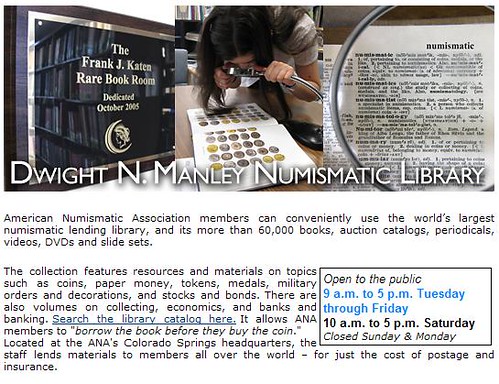
To visit the ANA Library web page. See: www.money.org/Content/NavigationMenu/ExploretheWorldofMoney/Library/
QUERY: ARLIE SLABAUGH'S COMMEMORATIVE COINAGE RESEARCH NOTES SOUGHT
Jim Harris writes:
QUERY: AUSTRIAN NOTGELD REFERENCE SOUGHT
Dave Kellogg writes:QUERY: CORPUS OF THE COINS OF THE JEWISH WAR
Bill Rosenblum writes:Does anybody know if this was an off-print of the larger book? When was it printed and by whom? I have not seen this nor have a few others who I have spoken to who specialize in ancient Jewish numismatics. Perhaps one of my fellow Bibliomaniacs can help. Thanks. I can be reached at Bill@Rosenblumcoins.com
MORE ON NUMISMATIC MOTTO TRANSLATIONS
Regarding our discussion of coin motto translations, Paul Schultz writes,Regarding obscure translations, there was a series of articles in The Numismatist entitled Coin Mottoes and Their Translations, by Stuart Mosher. It started in April 1948 and ended in September 1948.
It is 35 pages of mostly Latin mottos and their English meanings. From them, many of the abbreviations can be worked out. It was a blessing when I first started collecting older coins, but is poorly known now due to the number of years since it was published. Just copying this data onto a website (with ANA permission) would be beneficial for many collectors, since there are so may translations in that series of articles.
Additional information, if permission can be obtained, from the introductory sections of Sear’s Roman Coins and their Values, and especially Van Meter’s Handbook of Roman Imperial Coins, would provide a great deal of background on Roman Latin mottos and abbreviations.
Combining all three would provide all the information on Latin inscriptions and abbreviations that most people would need for 95% of their coins.
NEW COIN LAYING RECORD: 65 MILES!
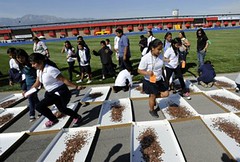 I am a fan of coin laying. I know it is a publicity stunt, but boy, it sure works. The object is to beat the distance of the last record and get in the Guinness Book of World Records.
I am a fan of coin laying. I know it is a publicity stunt, but boy, it sure works. The object is to beat the distance of the last record and get in the Guinness Book of World Records. The record had been held by a group of students in Fort Scott, Kansas -- 40 miles. Last week students in Orange County, California set out to string along a continuous chain of cents for 100 miles. That in honor of the Abraham Lincoln Bicentennial. Great goal. They had 14 million cents on hand and permission to use a speedway race track. But the sun set before they reached their goal.
 Total length achieved: 65 miles. There is only one rule in coin laying, the next coin has to touch the previous one. Start laying.
Total length achieved: 65 miles. There is only one rule in coin laying, the next coin has to touch the previous one. Start laying. Coin laying is different from "coin dropping" -- that is like the firemen holding a boot for citizens to contribute coins at stop signs. It is obviously different from "coin drop" -- that is were a numismatist spends a rare coin and publicizes it in the local press to see if someone finds the rarity. It is all for publicity.
Not everyone is enamored with coin laying. As a PR event once, I wanted our medal company to strike a medal for the Danbury Fair whose fairgrounds was two miles from our plant's door. I wanted to lay medals from the plant to the gate of the fairgrounds. I dashed off a memo to my boss, Bill Louth, president of Medallic Art, outlining how we could earn publicity by this stunt. I envisioned how we could sell the medals after we retrieved them, as a genuine souvenir of our stunt!
The memo came back with his handwritten comment something like "Please devote your time in this company to more worthwhile projects." Signed: "WTL."
Read how the California school kids did 65 miles of coin laying: Students set record for lining up pennies (www.ocregister.com/articles/pennies-miles-flores-2346224-program-children)
QUIZ ANSWER: HENRY BEMIS, LAST BIBLIOPHILE ON EARTH
We had a deluge of responses to last week's Quick Quiz. I asked, "Who can tell us about the famous bibliophile pictured here?"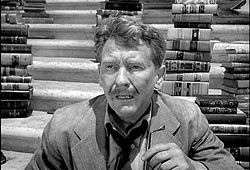
Byron Weston was the first to respond (correctly, of course), offering the Wikipedia page listed below, as did Bob Merchant and Alan Meghrig. Others who correctly answered include Larry Gaye, Tom DeLorey, Greg Burns, Larry Sekulich, Bob Mueller, Dave Lange, Richard Jozefiak, Katie Jaeger, Ton Rigney, Sam Deep, Myron Xenos, and Mike Greenspan.
Larry Koblenz at first guessed Ray Walston, who was best known for his starring role in "My Favorite Martian." His wife set him straight. The rest of his answer was spot-on. We have a lot of old-time TV show fans reading The E-Sylum.
Steve M. Tompkins writes:
Pete Smith writes:
 Witness Mr. Henry Bemis, a charter member in the fraternity of dreamers. A bookish little man whose passion is the printed page but who is conspired against by a bank president and a wife and a world full of tongue-cluckers and the unrelenting hands of a clock. But in just a moment Mr. Bemis will enter a world without bank presidents or wives or clocks or anything else. He'll have a world all to himself...
Witness Mr. Henry Bemis, a charter member in the fraternity of dreamers. A bookish little man whose passion is the printed page but who is conspired against by a bank president and a wife and a world full of tongue-cluckers and the unrelenting hands of a clock. But in just a moment Mr. Bemis will enter a world without bank presidents or wives or clocks or anything else. He'll have a world all to himself...Steve M. Tompkins writes:
He delights in taking any moment to read, through his incredibly thick "coke-bottle" glasses, even on his salaried time. He is constantly harassed by his wife, customers and boss for his love of print to the point that he must sneak into the bank's vault where he works to read on his lunch hour.
During one such visit, a nuclear bomb blast levels his city, leaving him unscathed, whereupon he exits to find that he has "time enough at last" to read all he wants when he finds the local library's contents scattered about.
At this point, (warning: spoiler!) he stacks the books into towers and rejoices in the solitude that will allow him to read everything he can...but in reaching for a particular book, his glasses slip off his face and smash....leaving him to mutter: "That's not fair... that's not fair at all... There was time now.... There was..all the time I needed!.. It's not fair". The scene then closes with the image panning away from a crying Bemis. (this synopsis is from the IMDB (Internet Movie Database)
At this point in time (knock on wood), I am still able to see and do everything without the use of glasses. Someday that may change and as I am an avid reader of many things, I certainly hope I am never in the same position as Henry Bemis!
Bill Malkmus writes:
Rich Mantia writes:
John Cadorini writes:
From Wikipedia:
By the way, did you know that The Twilight Zone Tower of Terror, a theme park ride at Disney's Hollywood Studios has a replica of Henry Bemis's broken glasses in the lobby? Look for them the next time you visit! -Editor
Alan V. Weinberg adds:
They talked and my wife recognized his voice. "You're the Penguin on Batman!", a TV series that she watched as a child. Mr. Meredith was amused that someone would recognize his voice, but not him, from perhaps the most unsophisticated but widely-known part he ever played!
To read the Wikipedia entry on "Time Enough to Last", see: http://en.wikipedia.org/wiki/Time_Enough_at_Last
NUMISMATIC PUBLICATIONS: ELECTRONIC VERSIONS EDGING OUT PRINT?
It's one thing for a little newsletter like The E-Sylum to be electronic, but when major hobby publishers adopt pricing policies that reflect the true costs of print and electronic publishing, it's only a matter of time before the vastly cheaper electronic format becomes the market leader. -Editor
In one timely example, NBS webmaster Bruce Perdue writes:
Under the new fee structure, which takes effect for members on June 1 and for nonmembers on April 1, a basic membership including online delivery of The Numismatist will be $28 per year – an $8 decrease. Regular membership, which includes monthly mail delivery of the magazine, will be $46 per year – an increase of $10.
Members in both tiers will otherwise receive the same ANA benefits including the privilege of submitting coins and paper money directly for grading and conservation services to Numismatic Guaranty Corp., Paper Money Guaranty and Numismatic Conservation Services and full use of the Dwight N. Manley Numismatic Library.
“We are restructuring rates to better reflect the true costs of delivering service to our members,” said ANA Executive Director Larry Shepherd. “Raising regular membership dues is necessary to reflect cost increases over the past several years. At the same time, I am pleased to introduce our newest basic membership tier with a reduction in dues. This option allows members to enjoy all their member benefits including the environmentally friendly online magazine. The two tiers provide a choice that can work for everyone.”
Annual dues for basic membership (online magazine only) were set at $14 for both juniors (17 and younger) and associate members. Regular juniors will pay $26 annually, and regular club fees were raised to $75, reflecting the many benefits clubs receive for their members who do not belong to the ANA. International members who are mailed the magazine will pay an additional $3 per month above the regular membership dues.
To read the complete press release, see: ANA Board Sets New Membership Rates New tiers provide more choice (www.money.org/AM/Template.cfm?Section=Home
&Template=/CM/ContentDisplay.cfm&ContentID=14370)
John and Nancy Wilson add:
By the way, this announcement comes at a time when the troubled organization is announcing its first balanced budget in some time. Congratulations! ANA Board Approves Balanced Operating Budget (www.coinnews.net/2009/03/26/ana-board-approves-balanced-operating-budget/)
1931 BAYONNE BRIDGE DEDICATION MEDAL
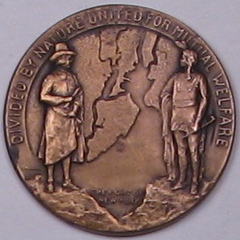 The seller describes the coin as "Very Scarce 1931 Port Authority of New York (and New Jersey) "Bayonne Bridge Dedication" Whitehead, & Hoag made 33mm. Bronze Token Medal."
The seller describes the coin as "Very Scarce 1931 Port Authority of New York (and New Jersey) "Bayonne Bridge Dedication" Whitehead, & Hoag made 33mm. Bronze Token Medal."The Bayonne Bridge was built in 1931.
To read the complete article, see: Bayonne on the block: "Rare" Bayonne Bridge coin on eBay (www.nj.com/bayonne/index.ssf/2009/03/
bayonne_on_the_block_rare_bayo.html)
THE BOOK BAZARRE
MORE ON BROCKAGES
Mike Ellis writes:Then the original coin and the smaller planchet were struck forcing the smaller planchet into the surface of the coin. So now, the original coin has been struck a second time whether the first strike is visible or not. At the same time, the smaller planchet gets struck for the first time and the relief elements from the original coin are transferred in reverse and incused to the smaller planchet.
That newly struck, smaller planchet is now a brockage on an undersized planchet.
Chick's coin is a gorgeous, first stage brockage and the mate to Bill's coin would look very much the same except not all of the design would have transferred simply because it was smaller in diameter. To complicate matters even more, it appears Bill's coin, though most likely genuine and highly collectible in its own right, and the resulting and missing brockage were almost undoubtedly created on purpose.
Notice how the design elements inside the indent and the normal elements outside of the indent match so perfectly. The odds of that happening are astronomical against it unless it were "helped." Most likely the original coin was snuggly seated back onto the reverse die that had struck it the first time with the smaller diameter planchet hand placed on top and then struck.
Somewhere out there is or was a gorgeous brockage on an undersized planchet that would fit with Bill's coin as snuggly as two pieces of a puzzle!"
Below are images of Bill and Chick's coins side-by-side.
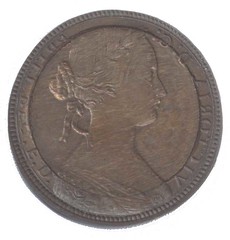

BRITAIN'S LARGEST COUNTERFEITING RING ABOUT TO BE SENTENCED
 A gang of forgers who ran one of Britain's biggest banknote scams from the suburban home of an 83-year-old man is about to be sentenced.
A gang of forgers who ran one of Britain's biggest banknote scams from the suburban home of an 83-year-old man is about to be sentenced.More than £5 million worth of almost faultless fake £20 and 50 euro notes were printed in Dennis Hancox's front room in Chiswick, west London.
They were then sold on to criminal gangs and the forgeries made their way into circulation throughout Europe, at one stage causing a nationwide alert on Bank of England and Bank of Scotland £20 notes.
Detectives from the Serious and Organised Crime Agency said the gang, with an average age of almost 60, ran the counterfeit operation like a professional business, with senior managers and a computer expert running a number of production sites in both London and Glasgow.
The notes were first printed on an industrial lithograph machine, the size of an office, and then cut and sent to Hancox's home to be "foiled" and finished using a £12,500 toner fuser machine.
A Bank of England forgery expert said the only differences between the gangs notes and real ones was the type of ink used and the quality of the watermark.
To read the complete article, see: Forgers face jail for banknote scam (www.itv.com/News/Articles/Forgers-face-jail
-for-banknote-scam-249484995.html)
BANK OF ENGLAND EXHIBIT: THE TENNER
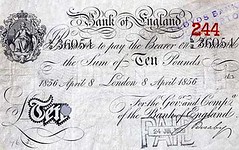 Deep in an underground vault bleached by fluorescent light, he pushed the forged bank note towards me. It was a handsome production, dated 1936, a big white tenner, promising to pay the bearer. This was part of £134 million counterfeited by the Germans, some of which came into circulation in Britain. Today we call it quantitative easing. Then, it was economic warfare.
Deep in an underground vault bleached by fluorescent light, he pushed the forged bank note towards me. It was a handsome production, dated 1936, a big white tenner, promising to pay the bearer. This was part of £134 million counterfeited by the Germans, some of which came into circulation in Britain. Today we call it quantitative easing. Then, it was economic warfare. That was why the white £10 note, 8in by 5in, was taken out of circulation in 1943. It had first been issued 250 years ago, in 1759, and it looked much the same all that time. The thinking, explains John Keyworth, Curator of the Bank of England Museum, the man locked in the vault with me, had been that a simple design was a defence against counterfeiters, whose mistakes would be more easily spotted.
To celebrate the tenner's anniversary, a display has been added to the Bank of England Museum. The £15 note is there, too, which sounds as funny now as a £2 coin used to. If you like money this is a good place to visit. If you like history it's even better.
No note was immune from imitation. What one engraver could make, another could copy. In 1855, the year the Daily Telegraph was founded, Victorian technology found the weapon of the stereotype – every bank note could now be printed identically, without the variations of the engraving process. The forger's task was more hopeless.
To read the complete article, see: 'The Tenner' at the Bank of England Museum, review (www.telegraph.co.uk/culture/art/5054384/The-Tenner
-at-the-Bank-of-England-Museum-review.html)
COIN CARVER ALLAN FEINBERG
Feinberg says he never knows what will attract a particular customer. Some are looking for a coin related to their heritage or a favorite vacation destination, while others are attracted to an image or symbol. His designs are so intricate and precise that customers often ask if he uses a laser, but Feinberg uses a traditional jewelers saw frame. "If I had a laser," Feinberg laughs, "I'd be doing eye surgery."

To read the complete article, see: Rare Coins: Allan Feinberg craves spare change into jewelry (www.mycentraljersey.com/article/20090324/GETPUBLISHED/903240314)
WOMAN CASHES IN DOUBLE EAGLE GOLD COINS AT FACE VALUE FOR GROCERY MONEY
The Double Eagle coins have a face value of $20 each, but are actually worth 50 times that just based on the current price of gold. The oldest of the coins was minted in 1875. The newest, in 1927.
Each coin weighs close to an ounce. They are 90 percent gold and 10 percent copper.
Zions Bank's executive vice president over marketing and communications Rob Brough said the coins have not been appraised.
Banks deal only in face value transactions, so a bank teller paid the woman $280 in the March 16 exchange, Brough said. The woman told the teller she had groceries waiting at a nearby Wal-Mart, which had refused the coins as payment.
Brough said the bank wants to return the coins to their owner. But so far, there is little information to go on. A bank surveillance video shows a woman with short, dark hair who may be in her 20s or 30s.
To read the complete article, see: Traded: Woman cashes in rare coins for grocery money at St. George bank (www.fox13now.com/news/sns-ap-ut--rarecoins,0,6366083.story)
FEATURED WEB SITE: LUDWIG GIES: CAST ART MEDALS FROM THE GREAT WAR
This week's Featured Web site is Henry Scott Goodman's exhibit of of the World War I art medals of Ludwig Gies, which recently won the Best of Show at the ANA National Money Show. For images of the cases, click on the Ribbon image link on the home page or = www.crestviewcable.com/~archy2/gies/bofs.html. The link below is the home page of the web recreation of the exhibit text and images.During this same time period Gies attended the City Crafts School (1906-1908) where he learned sculpture and architectural drawing. Additionally, he attended the College of Arts and Crafts from 1908-1910 where he studied under sculptor Heinrich Waderé and medallist Maxmilian Dasio. In 1910 he began sculptural studies at the Bavarian Academy of Arts whereby all of his previous studies culminated in Gies’ mastery of craftsmanship, technical skill, and understanding of form and material.
Gies created approximately 150 WWI medal designs between 1913-1918. He became known and admired for his ability to create monumentality in the smallest of spaces.
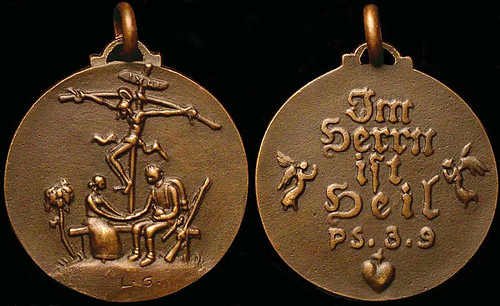
http://www.crestviewcable.com/~archy2/gies/
